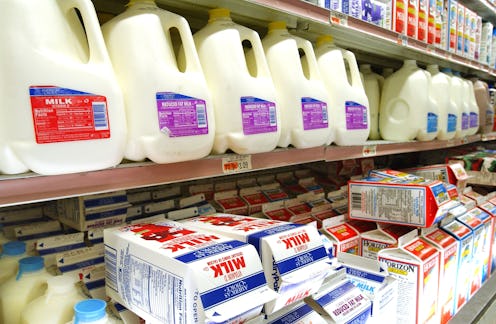Books
5 Creepy 'Milk Carton' Details You Missed As A Kid
Growing up, I was an avid reader, grabbing all the Judy Blume and Lois Lowry novels I could get my hands on. I read quickly, though, and soon, I was forced to move onto the books on my parents' shelves. Predictably, this presented a problem: Most of those were works not quite meant for my age. They were novels I might've been better off waiting a few years before tackling: The Lord of the Rings (too confusing), The Red Pony (unbearably boring), The World According to Garp (terrible at 11, but a masterpiece at 20). Before long, I was back to my own demographic — books actually meant for pre-teens like me.
As it turns out, though, even some of those supposedly "YA" novels had their fair share of adult content — such as The Face on the Milk Carton series, a group of beloved books by Caroline B. Cooney with plenty of material that went way over my 11-year-old head. Also known as the Janie Johnson series, Milk Carton and its three sequels followed the life of Janie, a 15-year-old girl who, after discovering her younger self's face on, yes, a milk carton, realizes she'd been kidnapped. It's heavy stuff, but you'd think Cooney would've toned down the drama for a pre-teen audience, right?
Wrong. The Milk Carton series was filled with definitely-not-YA references. When you first read, did you catch any of this stuff? I certainly didn't . . .
The Whole "Face on the Milk Carton" Idea in the First Place
I don't know about you, but when I read these books, it was the early '00s and the idea of putting a kidnapped child's face on a milk carton made absolutely no sense. The milk I knew didn't come with images, and besides, wasn't it just easier to put out an Amber Alert or show the kid's face each night on the news? The books explained the concept well enough that I got what it meant, but I just didn't understand why it was done.
Of course, if I'd read Milk Carton when it was actually published in 1990, I probably wouldn't have had an issue with the carton idea. But seeing as I wasn't a "young adult" until the early '00s, this once-commonplace concept felt dated, confusing, and not at all "YA."
Hannah's Cult
In the first book, Janie learns (or so she thinks) that her real mother is Hannah, who, as a teenager, joined a cult. She was "mated" to one of the guys there, who got her pregnant with Janie. She returned home, leaving the baby with her parents, who then moved away, changed their names, and did everything they could to avoid the cult's retaliation.
As an 11-year-old, I had no idea what any of this meant, and had to look up cults on Google, which, given the nightmares I had for a few days afterwards, was probably not the best idea.
The Prostitution
In Whatever Happened to Janie?, the titular character learns that Hannah (who she now knows was her kidnapper, not her mother), was arrested two years earlier for prostitution. My years of being a hardcore Rent fan had given me knowledge of the subject matter, but still, I wasn't expecting it to show up in a book recommended by my seventh grade teacher.
How Awful a Boyfriend Reeve Was
First of all, the main adjective applied to Janie's high school boyfriend is "rich," so that should give you an idea of his personality, or lack thereof. Then, there's the fact that the entire third book in the series is based around Reeve's inane, unforgivable decision to share Janie's very private story with his entire college.
Sure, Janie breaks up with him, but by the end of the book, they're inching towards reconciliation. At 11, I thought this was sweet. Now, I want to tell Janie she's insane.
Frank's Heart Attack/Stroke
In the series' final book, Frank, the father Janie grew up with, suffers a heart attack and stroke on the same day. It's a lot for Janie, and certainly for the reader, to take in, especially if the reader has just reached middle school. Plenty of YA books contain a tragedy or two, but usually, they're balanced out by happy, uplifting events. Not The Face on the Milk Carton series, though; these books, with their parental illnesses and prostitution and creepy cults, were as dark and twisty as they came.
Happy reading, right? Right.
